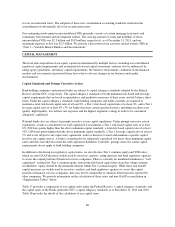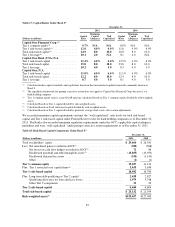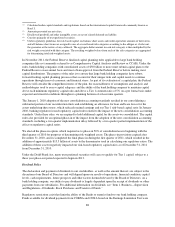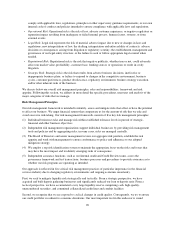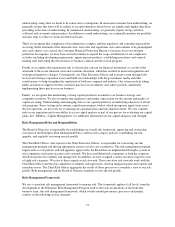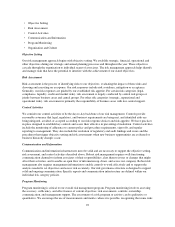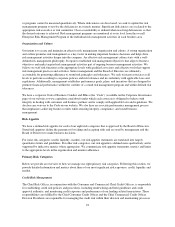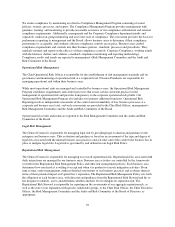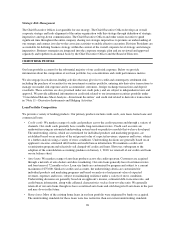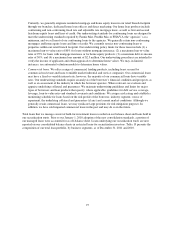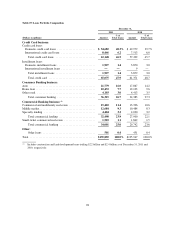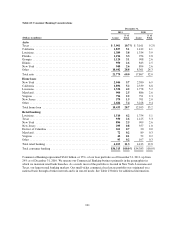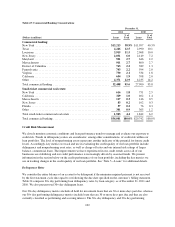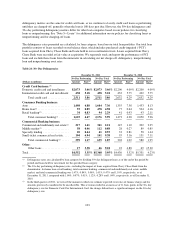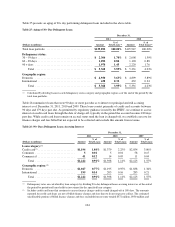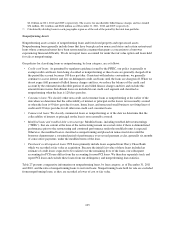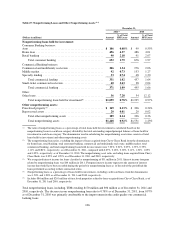Capital One 2011 Annual Report Download - page 116
Download and view the complete annual report
Please find page 116 of the 2011 Capital One annual report below. You can navigate through the pages in the report by either clicking on the pages listed below, or by using the keyword search tool below to find specific information within the annual report.
Strategic Risk Management
The Chief Executive Officer is responsible for our strategy. The Chief Executive Officer develops an overall
corporate strategy and leads alignment of the entire organization with this strategy through definition of strategic
imperatives and top-down communication. The Chief Executive Officer and other senior executives spend
significant time throughout the entire company sharing our strategic imperatives to promote an understanding of
our strategy and connect it to day-to-day associate activities to enable effective execution. Division Presidents are
accountable for defining business strategy within the context of the overall corporate level strategy and strategic
imperatives. Business strategies are integrated into the corporate strategic plan and are reviewed and approved
separately and together on an annual basis by the Chief Executive Officer and the Board of Directors.
CREDIT RISK PROFILE
Our loan portfolio accounts for the substantial majority of our credit risk exposure. Below we provide
information about the composition of our loan portfolio, key concentrations and credit performance metrics.
We also engage in certain non-lending activities that may give rise to credit and counterparty settlement risk,
including the purchase of securities for our investment securities portfolio, entering into derivative transactions to
manage our market risk exposure and to accommodate customers, foreign exchange transactions and deposit
overdrafts. These activities are also governed under our credit policy and are subject to independent review and
approval. We provide additional information on credit risk related to our investment securities portfolio under
“Consolidated Balance Sheet Analysis—Investment Securities” and credit risk related to derivative transactions
in “Note 11—Derivative Instruments and Hedging Activities.”
Loan Portfolio Composition
We provide a variety of lending products. Our primary products include credit cards, auto loans, home loans and
commercial loans.
•Credit cards: We market a range of credit card products across the credit spectrum and through a variety of
channels. Our credit cards generally have variable long-term interest rates. Credit card accounts are
underwritten using an automated underwriting system based on predictive models that we have developed.
The underwriting criteria, which are customized for individual products and marketing programs, are
established based on an analysis of the net present value of expected revenues, expenses and losses, subject
to a further analysis using a variety of stress conditions. Underwriting decisions are generally based on an
applicant’s income, estimated debt burden and credit bureau information. We maintain a credit card
securitization program and selectively sell charged-off credit card loans. However, subsequent to the
adoption of the consolidation accounting guidance on January 1, 2010, we retain all of our credit card loans
on our balance sheet.
•Auto loans: We market a range of auto loan products across the credit spectrum. Customers are acquired
through a network of auto dealers and direct marketing. Our auto loans generally have fixed interest rates
and loan terms of 72 months or less. Loan size limits are customized by program and subject to a current
maximum of $75,000. Similar to credit card accounts, the underwriting criteria are customized for
individual products and marketing programs and based on analysis of net present value of expected
revenues, expenses and losses, subject to maintaining resilience under a variety of stress conditions.
Underwriting decisions are generally based on an applicant’s income, estimated debt-to-income ratio, and
credit bureau information, along with collateral characteristics such as loan-to-value ratio. We generally
retain all of our auto loans, though we have securitized auto loans and sold charged-off auto loans in the past
and may do so in the future.
•Home loans: Most of the existing home loans in our loan portfolio were originated by banks we acquired.
The underwriting standards for these loans were less restrictive than our current underwriting standards.
96


